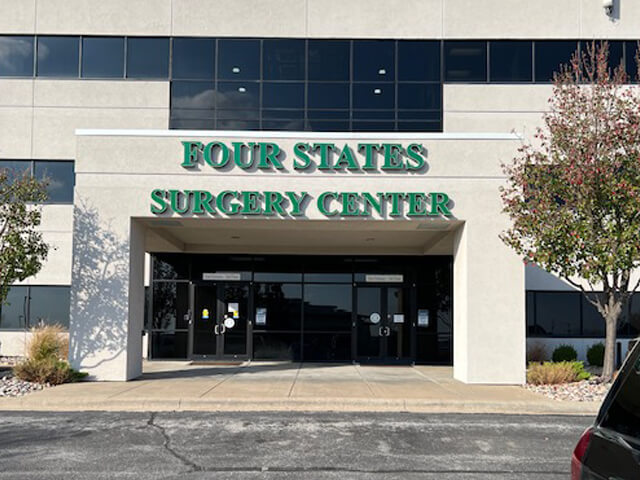Cataract Center
What Are Cataracts?

A cataract is a clouding of the natural lens inside of your eye. The lens is the part of your eye that helps focus light and images onto the back of your eye.
A cataract can make it harder for you to see things clearly and make colors look less bright. Cataracts are a common eye condition that mostly happens in older people but can also happen to younger people due to certain medical conditions or injuries.
Cataract surgery is the most effective treatment to remove a cataract and improve vision. If cataract symptoms interfere with your daily life, it may be time to have cataract surgery.
What Happens Before Cataract Surgery?
Before having cataract surgery, you will need to visit your eye doctor at Missouri Eye Institute for a cataract evaluation. At this visit, your eye doctor will thoroughly evaluate your eyes and ask you about your visual symptoms to ensure that it is time for cataract surgery.
During your cataract evaluation, your eye doctor will do some tests to determine the best power for your replacement lens. This will ensure that you have the best vision outcome.
They will also check your eye health and ensure you don’t have any other eye problems. Your eye doctor will discuss your Intraocular Lens (IOL) options and help you determine which IOL may be best for you based on your vision goals, lifestyle, and budget.
After this exam, your eye doctor will give you instructions on how to prepare for the surgery, such as not eating or drinking anything for a certain amount of time before the surgery or the possible need to discontinue certain types of medication.
When you arrive at the surgery center on the day of the procedure, you will spend a little time in pre-op, being prepared for the procedure. Your eye doctor will dilate your eyes and numb the surface with eye drops.
What Happens During Cataract Surgery?
Cataract surgery restores your vision by removing the cloudy natural lens and replacing it with a clear artificial Intraocular lens, also known as an IOL. First, your cataract surgeon will make a small incision in the clear front surface of your eye, known as a cornea.
At Missouri Eye institute, our cataract surgeons utilize an advanced laser called a femtosecond laser during cataract surgery. This laser is used to create precise incisions in the eye and helps increase the procedure’s accuracy and safety.
Next, they will use special tools to break up and remove the cataract. After the cataract is removed, your cataract surgeon will insert a new Intraocular Lens (IOL) and position it in place.
This new lens will help you see clearly again and eliminate your cataract symptoms. After it is in place, the surgery will be complete.
The tiny incision in your cornea will heal naturally during recovery. The entire procedure usually takes about thirty minutes to an hour and is outpatient, meaning you get to go home the same day.
What Happens After Cataract Surgery?

After you have cataract surgery, your vision should be clearer. However, while your eyes heal, you might have trouble seeing for a short time afterward, like blurriness or halos around lights.
Many people notice an improvement in their vision right away. Although in some cases, it may take a while for your eyes to adjust and for you to witness the full potential of your vision.
After the procedure, you will be sent home with instructions on how to help your eyes heal. It is essential that you follow these instructions and use any eye drops as directed to help avoid any complications during the recovery process.
Your eye doctor might also ask you to wear a shield to protect your eye, especially while sleeping. They will want to see you the day after cataract surgery to ensure your eyes are healing properly.
You will also need to go back to your eye doctor a few times after this appointment over the next month or so. Although you will likely notice a total improvement in your vision after a few weeks, it can take anywhere from four to six months to fully recover from cataract surgery.
What Types of IOLs Are Available at Missouri Eye Center?
Choosing an Intraocular Lens (IOL) to replace your natural lens is one of the most critical parts of the cataract surgery process. At Missouri Eye Institute, our cataract surgeons offer a variety of lenses to match various vision goals and budgets.






Monofocal
A Monofocal IOL (Monofocal Lens) is a standard Intraocular Lens (IOL) that is typically covered by insurance. This type of lens helps improve your vision, but it only provides clear vision for either close-up or far-away things, not both at the same time.
This means that you will still need to wear glasses for either close-up tasks like reading or for far-away tasks like watching TV. Your eye doctor will talk to you about which type of lens is best for you and your daily needs.
Since this type of lens is typically covered by insurance, it is often cheaper. If reducing dependency on visual aids after cataract surgery is important to you, a premium Intraocular Lens (IOL) may be a better choice to accomplish your vision goals.
Multifocal Intraocular Lens (IOL)
A multifocal IOL is a premium lens designed to help you see clearly at multiple distances, like close up and far away. This means that if you choose a multifocal IOL, you may be able to see things clearly without needing to wear glasses all the time.
However, some people may still need glasses for certain tasks, like reading or using the computer. Your eye doctor will talk to you about the benefits and limitations of a multifocal IOL to help you decide if it’s right for you.
Accommodative Intraocular Lens (IOL)
An accommodative IOL is a premium lens that can allow you to see clearly at all distances and is designed to move and change shape inside your eye, similar to your natural lens. This means with an accommodative lens, you will likely be able to have clear vision at near, distance, and in between, with reduced dependency on visual aids.
It’s important to remember that not everyone will have the same results with accommodative IOLs. Some people may still need glasses for certain tasks, like reading or using the computer.
Your eye doctor will be able to give you more information and help you make the best decision for your needs.
Toric Intraocular Lens (IOL)
A toric IOL is a premium lens that is designed to correct a common type of vision problem called astigmatism. Astigmatism is a refractive error that occurs when your eye is shaped more like a football than a basketball, which can result in blurry or distorted vision.
A toric IOL is shaped differently from other artificial lenses and can help correct astigmatism so you can see things more clearly. Your eye doctor will check your eyes to see if you have astigmatism and if a toric IOL is the best option to help correct it.
Do you want to learn more about cataract surgery? Schedule a cataract evaluation at Missouri Eye Institute in Branson, MO, today!











